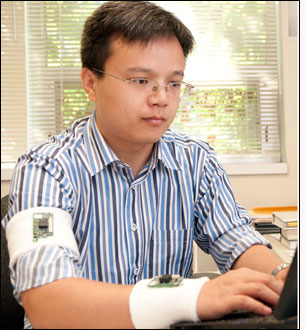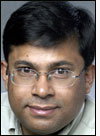When doctors want to monitor a patient’s activity level, either for sports-medicine or weight-management applications, they generally have to rely on that individual’s own account of his or her activity, or on a small pedometer worn by the patient when going about his or her daily routine. Researchers at Michigan State University (MSU), however, have developed a system that takes a leap ahead of the former methods, by using a network of RFID-enabled sensors to track not only the movements of different body parts, but also their angle and proximity to each other.
The system includes three RFID tags: one attached to a person’s upper arm, another on a wrist and a third on one of the ankles. Each tag communicates with the other two, enabling the system’s software to calculate the amount of movement and angle of a person’s limbs, as well as determine how close they are to each other.

The system was the result of collaboration between MSU’s electrical engineering and kinesiology departments, according to Subir Biswas, an electrical engineering professor who serves as the department’s associate chair for research and is also the director of the university’s Networked Embedded and Wireless Systems (NeEWS) Laboratory. Its development is being funded by the National Institute of Health (NIH). Biswas has a background in low-power wireless networking, and after he began working in June 2008 with Karin Pfeiffer, an assistant professor of kinesiology at MSU, he discovered a way in which the technology could be employed in the medical or physical training arena.
Accelerometers traditionally provide a way to measure the quantity of activity in which an individual is engaged, by counting footsteps and other major movements. The number of those movements recorded by the accelerometer can then be entered directly into a computer by hand—or, in some cases, the data on the device can be uploaded to a computer. But the accelerometers alone provide very little visibility into smaller body movements, or the position the body is in throughout the day, which are details that could impact an individual’s health. “In reality,” Biswas says, “the amount of metabolic energy being expended is difficult to gauge with an accelerometer alone.”
What Biswas and his team of researchers developed was a wearable RFID tag with three different sensors: one that measures tilt, to determine the angle of the body part wearing that sensor; an accelerometer, to monitor the number of body movements; and a proximity sensor, to ascertain how close the tag is to the other two on the body (which requires the sensors to transmit to each other). A total of three tags are attached to a subject’s body—typically, to a person’s wrist, upper arm and ankle. In this way, users can gain much more sophisticated data regarding a body’s movement and positioning throughout the day.To communicate with the other tags, and to upload the data onto a server or a laptop computer, each tag comes with an ultrahigh-frequency (UHF) 900 MHz EPC Gen 2 RFID inlay and a battery to transmit information at preset intervals. Each tag captures the transmissions of the other two tags on the body, measuring the signal strength in order to calculate proximity—for example, Biswas says, the distance from the tag on the wrist to those on the ankle and upper arm at the moment of transmission. The accumulated proximity data is then stored on one of the three tags designated to be the “mother tag,” which transmits that information, along with data generated by its own accelerometer and tilt sensor, to an RFID reader plugged into a laptop via a USB connection. The interrogator also captures all of the accelerometer and tilt sensor data from the other two tags and forwards that information to software on the laptop, or to a server via the Internet, where the data can then be linked to the patient’s ID number and stored.
Software designed by Biswas’ team determines the amount of movement for that individual, based on the sensor data, including the proximity data provided by the mother tag. In this way, by detecting where the tags are located in relationship to each other, as well as the changing angles and the number of movements, the software can determine the amount of energy being expended.
The calculations regarding the amount of energy expended could be made available to physicians, and alerts could be sent in the case of unusual activity (more than what is considered healthy for that individual) or inactivity. The software can provide “a big picture to compute the amount of metabolic energy being expended,” Biswas says, as well as a small picture indicating an individual’s movements, based on the many sensor readings each day.
One prototype has been built, and the system is currently being tested by students in a gymnasium operated by MSU’s kinesiology department. The system is being tested against video recordings showing an individual’s activity, which are compared against the sensor-network results. Once the researchers have proven that the prototype system can provide results that compare accurately with what is shown on video, Biswas expects the system to continue being tested without the video comparison. At that point, he says, the school plans to apply for an additional NIH grant to begin pre-product development work to redesign the tags and the network to be “more user-friendly, with a scalable system development” that could work in a variety of applications (such as on a server, or integrated into a health-care company’s back-end system).
The most likely applications of this technology, Biswas says, may initially be in the sports medicine industry, as well as for weight management, for which data about an individual’s activity is of most value. The technology developed by Biswas and his group has also been used by NASA to monitor the movements of individuals, he says, though he declines to comment on the specifics of that project.


